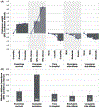Developing an instrument to assess patient preferences for benefits and risks of treating acute myeloid leukemia to promote patient-focused drug development
- PMID: 29565196
- PMCID: PMC8799376
- DOI: 10.1080/03007995.2018.1456414
Developing an instrument to assess patient preferences for benefits and risks of treating acute myeloid leukemia to promote patient-focused drug development
Abstract
Objective Acute myeloid leukemia (AML) is a progressive blood cancer with few effective treatment options. As part of a patient-focused drug development (PFDD) initiative led by the Leukemia and Lymphoma Society (LLS), this study sought to use a community-centered approach to develop and pilot an instrument to measure patient preferences for the benefits and risks of treating AML. Methods Instrument development was informed by a literature review, engagement with expert stakeholders (n = 12), engagement with community stakeholders, and pre-testing. A discrete-choice experiment (DCE), in which participants made choices between 16 pairs of hypothetical treatments, was developed with five attributes: event-free survival, complete remission, time in hospital, short-term side-effects, and long-term side-effects. A pilot test was conducted and analyzed using conditional logistic regression. Results are presented using relative attribute importance (RAI) scores. Results Patients with AML and caregivers were engaged in developing (n = 15), pre-testing (n = 13), and pilot testing (n = 26) the instrument. The pilot included patients with AML (n = 18) and caregivers of living or deceased patients with AML (n = 8). Participants had a mean age of 50 years (range =24-81), and were mostly college educated (n = 22), privately insured (n = 21), and employed (n = 13). Based on the DCE, complete remission was identified as the most important attribute (RAI =10), followed by event-free survival (3.7), time in hospital (2.8), long-term side-effects (2.3), and short-term side-effects (2.1). Conclusion The mixed-methods approach to PFDD was welcomed by all stakeholders and there was strong endorsement to implement this DCE as part of a national survey. Key points for decision makers The Leukemia and Lymphoma Society (LLS) initiated an independent effort to promote patient-focused drug development (PFDD). This study presents the development and piloting of a preference study as a first step in this initiative. Results of this pilot study were used to guide a PFDD meeting to discuss the lived experience of patients and caregivers affected by AML. Productive engagement by all patients, caregivers, and stakeholders throughout the process resulted in strong endorsement of the project's approach and recognition of the need to conduct a national study.
Keywords: Acute myeloid leukemia (AML); Community engagement; Instrument development; Stated preference.
Figures



Similar articles
-
Age at Diagnosis and Patient Preferences for Treatment Outcomes in AML: A Discrete Choice Experiment to Explore Meaningful Benefits.Cancer Epidemiol Biomarkers Prev. 2020 May;29(5):942-948. doi: 10.1158/1055-9965.EPI-19-1277. Epub 2020 Mar 4. Cancer Epidemiol Biomarkers Prev. 2020. PMID: 32132149 Free PMC article.
-
Developing and piloting an instrument to prioritize the worries of patients with acute myeloid leukemia.Patient Prefer Adherence. 2018 Apr 27;12:647-655. doi: 10.2147/PPA.S151752. eCollection 2018. Patient Prefer Adherence. 2018. PMID: 29731612 Free PMC article.
-
A community-engaged approach to quantifying caregiver preferences for the benefits and risks of emerging therapies for Duchenne muscular dystrophy.Clin Ther. 2014 May;36(5):624-37. doi: 10.1016/j.clinthera.2014.04.011. Clin Ther. 2014. PMID: 24852596
-
A Systematic and Critical Review of Discrete Choice Experiments in Asthma and Chronic Obstructive Pulmonary Disease.Patient. 2022 Jan;15(1):55-68. doi: 10.1007/s40271-021-00536-w. Epub 2021 Jul 12. Patient. 2022. PMID: 34250574 Free PMC article.
-
A Systematic Review of Discrete Choice Experiments and Conjoint Analysis on Genetic Testing.Patient. 2022 Jan;15(1):39-54. doi: 10.1007/s40271-021-00531-1. Epub 2021 Jun 4. Patient. 2022. PMID: 34085205
Cited by
-
A Systematic Review of Discrete Choice Experiments in Oncology Treatments.Patient. 2021 Nov;14(6):775-790. doi: 10.1007/s40271-021-00520-4. Epub 2021 May 5. Patient. 2021. PMID: 33950476
-
How Do Members of the Duchenne and Becker Muscular Dystrophy Community Perceive a Discrete-Choice Experiment Incorporating Uncertain Treatment Benefit? An Application of Research as an Event.Patient. 2019 Apr;12(2):247-257. doi: 10.1007/s40271-018-0330-8. Patient. 2019. PMID: 30259384
-
Utilising Patient and Public Involvement in Stated Preference Research in Health: Learning from the Existing Literature and a Case Study.Patient. 2021 Jul;14(4):399-412. doi: 10.1007/s40271-020-00439-2. Patient. 2021. PMID: 32748242 Free PMC article.
-
Using Social Media to Uncover Treatment Experiences and Decisions in Patients With Acute Myeloid Leukemia or Myelodysplastic Syndrome Who Are Ineligible for Intensive Chemotherapy: Patient-Centric Qualitative Data Analysis.J Med Internet Res. 2019 Nov 22;21(11):e14285. doi: 10.2196/14285. J Med Internet Res. 2019. PMID: 31755871 Free PMC article.
-
Age at Diagnosis and Patient Preferences for Treatment Outcomes in AML: A Discrete Choice Experiment to Explore Meaningful Benefits.Cancer Epidemiol Biomarkers Prev. 2020 May;29(5):942-948. doi: 10.1158/1055-9965.EPI-19-1277. Epub 2020 Mar 4. Cancer Epidemiol Biomarkers Prev. 2020. PMID: 32132149 Free PMC article.
References
-
- Grigoropoulos NF, Petter R, Van’t Veer MB, et al. Leukaemia update. Part 1: diagnosis and management. BMJ 2013;346:f1660. - PubMed
-
- Khwaja A, Bjorkholm M, Gale GE, et al. Acute myeloid leukaemia. Nature Rev Dis Primers 2016;2:16010. - PubMed
-
- DeSantis CE, lin CC, Mariotto AB, et al. Cancer treatment and survivorship statistics, 2014. CA Cancer J Clin 2014;64:252–71 - PubMed
-
- Döhner H, Estey EH, Amadori S, et al. Diagnosis and management of acute myeloid leukemia in adults: recommendations from an international expert panel, on behalf of the European LeukemiaNet. Blood 2010;115:453–74 - PubMed
Publication types
MeSH terms
Grants and funding
LinkOut - more resources
Full Text Sources
Other Literature Sources
Medical
Research Materials
